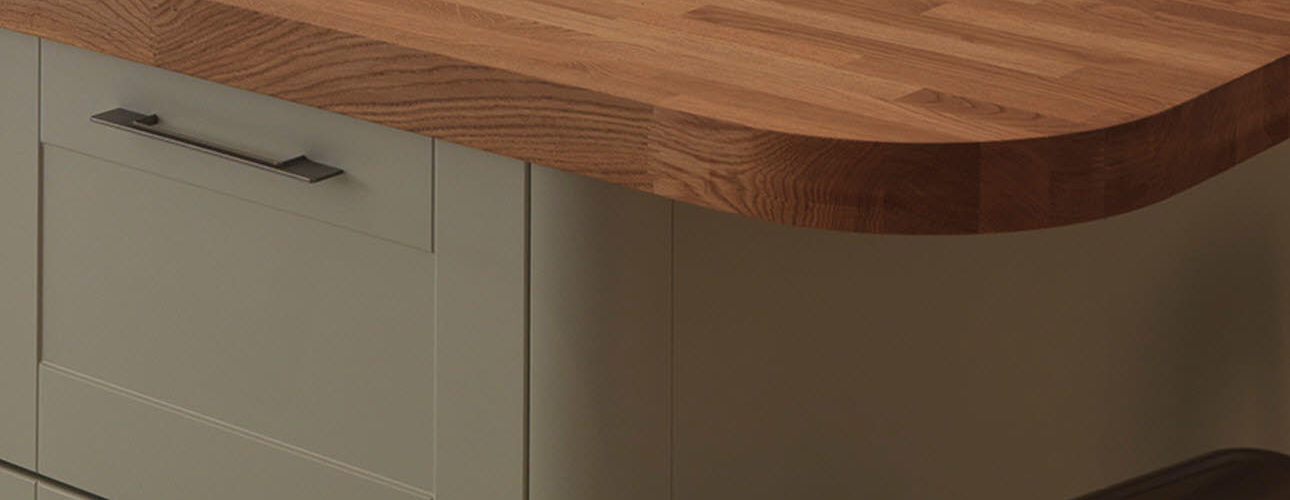If a solid wood worktop could talk, you just might discover that it has multiple personality syndrome. Wood is just that versatile and personable, but it’s best to leave the fictional adventures of talking wood to Pinocchio and get down to the real facts.
Fact #1 – Worktops have a versatile functionality.
Wooden worktops are a natural for multipurpose use. They are a preferred surface for work areas in a home office or craft bench, and are traditional favorites as kitchen countertops as well. They are sturdy and solid, but not too hard. If you have ever tried filling out paperwork on a ceramic surface, you will instantly appreciate the resilient virtues of wood.
Fact #2 – Solid wood offers a full array of design options.
Most solid wood worktops are the butcher block style. It’s pretty, it’s functional, and because it can be made from short lengths of wood, it can be modestly priced. But solid wood can offer so much beyond the ordinary. Natural wood colors offer a veritable palate of hues from white ash and beech to deep walnuts and ebony. In between are honeyed oaks, caramelized maples, warm red cherry wood and a variety of exotic choices. Solid worktops can be made from wide planks, glued strips, or inlaid mosaics to create effects that span traditional, antique, homespun, or clean contemporary looks.
Little known fact #3 – Wood is naturally resistant to bacteria.
A research study conducted at Albstadt-Sigmaringen University, Germany, tested cutting boards of pine, beech and two different plastics, polyethylene and poly propylene. Throughout the month long test, the pine and the beech both tested hygienically cleaner than the plastics. Other testing showed that fungus organisms died faster on pine heartwood than on plastic. Many woods, pine in particular, are not only safe for food surfaces, but have been proven to be natural biocides against microorganisms.
Fact #4 – Solid wood kitchen worktops are cost effective.
At $25–$50 per square foot, wood countertops are in the mid-range when compared with other materials. Much of wood’s enduring value comes from necessary, but relatively simple maintenance practices.
Fact #5 – Wood worktops are eco-friendly.
This is especially true when the wood has been harvested from forests using sustainable management programs. Because it is a better insulator, wood surfaces will feel warmer in cold weather than their stone or tile counterparts.
Fact #6 – Installation of wood countertops can be a great DYI project.
As in any DYI project, you need to learn about the proper procedure. Wood installation is not that difficult if you know what to look out for—moisture. Most wood countertops should be installed with a small gap between the back edge and the wall to allow for expansion caused by humidity. This means that an upstand, backsplash, or other trim will be used to cover the space. It is important that any gluing forms a moisture-proof seal so that the wood won’t discolor in the future. It is also a good idea to oil the underside and edges prior to installation to reduce warping.
Fact #7 – Solid wooden work surfaces require simple routine maintenance.
Depending upon the porosity of the variety of wood used, a new surface might take 3 – 5 coats of oil. End grains will need extra oil. The surface should be re-oiled whenever a drop of water no longer beads up. The most common oils used on wood are tung, linseed, and pure lemon oil. Olive oil is sometimes used on food preparation surfaces. Oils that contain petroleum distillates will darken the wood over time and should not be used for food prep areas. Wipe up excess liquids quickly. Prolonged contact with some metals can stain the wood.
Fact #8 – Resurfacing is an option.
With proper maintenance, resurfacing should not be necessary. Sometimes catastrophic accidents occur, and if they do, solid wood can be resurfaced instead of having to be replaced. Begin with a good soapy scrubbing, double rinsing, and thorough drying. Then evaluate the surface. If the scrubbing fixed it, apply several thin coats of oil. More extensive damage might require sanding or filling gouges with putty. In either of these cases, follow up with oil treatments.
Related Posts
- How to Choose Hardwood Flooring?
- Kitchen Worktops
- How To Stop Kitchen Worktops From Warping?
- Wood Worktops



